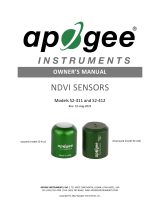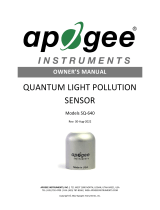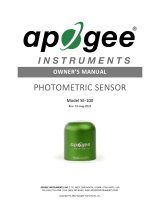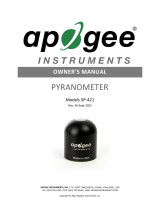apogee INSTRUMENTS SI-300 Owner's manual
- Category
- Motorcycle Accessories
- Type
- Owner's manual
This manual is also suitable for

Infrared Radiometer
SI-200 & 300 Series

Sample programming instructions are included with shipment and can
also be downloaded from our website at:
apogeeinstruments.com/infrared_temperature_sensors.htm
High
Low
Analog ground
High
Low
Infrared Radiometer
Accurate measurement of the leaf-to-air temperature gradient is
important for irrigation scheduling and the determination of energy
transfer, transpiration rate, and stomatal conductance in both single
leaves and plant canopies. This gradient is often less than 1 C, which
means the leaf temperature should be measured to within 0.1 C. To
achieve this accuracy, we measure and correct for changes in the
sensor body temperature.
Application
Measurement of surface temperature is a crucial component of energy
transfer. Accurate measurement of the leaf-to-air temperature gradient
is essential to the determination of transpiration rate and stomatal
conductance in both single leaves and plant canopies.
Wiring Diagram
Target
Yellow wire = high
Red wire = low
Sensor Body
Yellow wire = high
Red wire = low
Bare wire = analog ground
2

Atmospheric Transmission
The infrared radiometer window is reported as 6.5 to 14 µm. Although
the cut off at 14 µm is not sharp, radiation at those wavelengths is
minimum.
Cleaning
Debris on the radiometer is a common cause of low readings. Salt
deposits can accumulate on a sensor from evaporation of sprinkler
irrigation water and dust, which can accumulate during periods of low
rainfall. Salt deposits should be dissolved and removed with vinegar
and a soft cloth or q-tip. Dust and other organic deposits are best
removed with water, rubbing alcohol, or window cleaner. Never use
an abrasive cleaner on the window.
3

Correction for Sensor Body
Temperature
The output of infrared sensors is determined by the difference
between the target temperature and the temperature of the infrared
detector (the reference temperature). Consequently, an error in the
measurement of the detector reference temperature results in an error
in the measurement of the target temperature. The device used to
measure the detector temperature is not usually in perfect equilibrium
with the detector so reference temperature errors are particularly
large when the sensor body temperature uctuates. This error is
minimized by adding thermal mass around the detector to prevent
rapid temperature changes and to keep all parts of the sensor at the
same temperature. Published calibration procedures often describe
detailed procedures to determine the temperature and emissivity of
the black body calibration target but neglect the effect of sensor body
temperature.
4

5

Field of View
The eld of view (FOV) is reported as the half-angle of the apex of the
cone formed by the target (cone base) and the detector (cone apex).
The target is a circle form which 98% of the radiation viewed by the
detector is being emitted.
Model SI-211
Half Angle = 28°
6

Output
• 2 type K thermocouple wires
Accuracy
• SI-211 & SI-212: ± 0.5 C
• SI-311 & SI-312: ± 0.2 C
Optics
• Silicon lens
Wavelength Range
• 6.5 - 14 µm
Field of View (FOV)
• 28° half angle
Response Time
• Less than 1 second to
changes in target temperature
Input Power
• None
Datalogger Channels
• Two differential
Specications
Operating Environment
• -40 to 60 C
• Calibrated range: -15 to 60 C
• Highly water resistant
• Designed for continuous
outdoor use
Cable
• 5 meters of twisted, shielded
4-thermocouple wire with
casing
• Ending in pigtail leads
• Additional cable is available in
multiples of 5 meters
Dimensions
• 6.0 cm long
• 2.3 cm diameter
Warranty
• 1 year against defects in
materials and workmanship
7
-
 1
1
-
 2
2
-
 3
3
-
 4
4
-
 5
5
-
 6
6
-
 7
7
-
 8
8
apogee INSTRUMENTS SI-300 Owner's manual
- Category
- Motorcycle Accessories
- Type
- Owner's manual
- This manual is also suitable for
Ask a question and I''ll find the answer in the document
Finding information in a document is now easier with AI
Related papers
-
 apogee INSTRUMENTS S2-411-SS Owner's manual
apogee INSTRUMENTS S2-411-SS Owner's manual
-
 apogee INSTRUMENTS SQ-640-SS Owner's manual
apogee INSTRUMENTS SQ-640-SS Owner's manual
-
 apogee INSTRUMENTS SE-100-SS Owner's manual
apogee INSTRUMENTS SE-100-SS Owner's manual
-
 apogee INSTRUMENTS PS-100 Owner's manual
apogee INSTRUMENTS PS-100 Owner's manual
-
 apogee INSTRUMENTS IRR-P Owner's manual
apogee INSTRUMENTS IRR-P Owner's manual
-
apogee INSTRUMENTS MQ-500 Owner's manual
-
apogee INSTRUMENTS MQ-100 Owner's manual
-
 apogee INSTRUMENTS SP-421-SS Owner's manual
apogee INSTRUMENTS SP-421-SS Owner's manual
-
apogee INSTRUMENTS SQ-616 Owner's manual
-
apogee INSTRUMENTS SP-212 Owner's manual
Other documents
-
Apogee SI-4H1 Owner's manual
-
Apogee SI-1H1 Owner's manual
-
Campbell Scientific SI-111 and SI-111SS Precision Infrared Radiometers Owner's manual
-
Apogee SQ-614 Owner's manual
-
Apogee SQ-622 Owner's manual
-
Apogee SQ-610 EPAR SENSOR Owner's manual
-
Apogee SQ-614 Owner's manual
-
apogee INSTRUMENT SQ-500 Owner's manual
-
Apogee MQ-510 Owner's manual
-
Apogee MQ-510 Owner's manual














